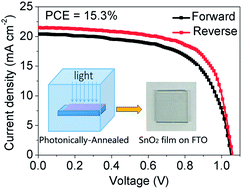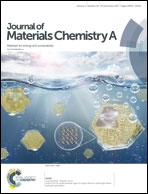Millisecond-pulsed photonically-annealed tin oxide electron transport layers for efficient perovskite solar cells†
Abstract
In recent years, hybrid organic–inorganic halide perovskite solar cells (PVSCs) have emerged as leading candidates for next-generation photovoltaic technologies. The architecture of PVSCs rely on charge transport layers to enable optimal efficiency and stability. In particular, tin oxide (SnO2) has been shown to be an effective electron transport layer (ETL) due to favorable energy level alignment, relatively wide band gap, and high environmental and thermal stability. However, traditional processing of SnO2 necessitates a high-temperature and/or long-duration sintering step that limits substrate choice and introduces manufacturing challenges. To overcome this limitation, we present here a rapid, low-temperature, solution-based method for SnO2 film fabrication based on intense pulsed photonic annealing. Following a comprehensive survey of the precursor solution and photonic annealing conditions, light exposure as short as 20 milliseconds is shown to provide a high-quality nanocrystalline SnO2 film at room temperature, enabling PVSCs with low hysteresis and high power conversion efficiencies exceeding 15%. Overall, this work establishes a processing pathway for SnO2-based PVSCs that is compatible with flexible substrates and high-throughput, roll-to-roll manufacturing.



 Please wait while we load your content...
Please wait while we load your content...